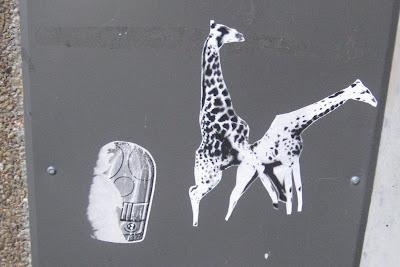quarta-feira, 8 de outubro de 2008
terça-feira, 7 de outubro de 2008
domingo, 5 de outubro de 2008
sábado, 4 de outubro de 2008
Graffiti
From Wikipedia, the free encyclopedia
Jump to: navigation, search
For other uses, see Graffiti (disambiguation).
Examples of modern graffiti styles
Spanish inscription at El Morro National Monument, 1605, with later graffiti
Graffiti (singular: graffito; the plural is used as a mass noun) is the name for images or lettering scratched, scrawled, painted or marked in any manner on property. Graffiti is sometimes regarded as a form of art and other times regarded as unsightly damage or unwanted. Some people think of it as art, others vandalism, and others, a culture of its own.
Graffiti has existed since ancient times, with examples going back to Ancient Greece and the Roman Empire.[1] Graffiti can be anything from simple scratch marks to elaborate wall paintings. In modern times, spray paint and markers have become the most commonly used materials. In most countries, defacing property with graffiti without the property owner's consent is considered vandalism, which is punishable by law. Sometimes graffiti is employed to communicate social and political messages. To some, it is an art form worthy of display in galleries and exhibitions, to others it is merely vandalism. There are many different types and styles of graffiti and it is a rapidly evolving artform whose value is highly contested, being reviled by many authorities while also subject to protection, sometimes within the same jurisdiction.
From Wikipedia, the free encyclopedia
Jump to: navigation, search
For other uses, see Graffiti (disambiguation).
Examples of modern graffiti styles
Spanish inscription at El Morro National Monument, 1605, with later graffiti
Graffiti (singular: graffito; the plural is used as a mass noun) is the name for images or lettering scratched, scrawled, painted or marked in any manner on property. Graffiti is sometimes regarded as a form of art and other times regarded as unsightly damage or unwanted. Some people think of it as art, others vandalism, and others, a culture of its own.
Graffiti has existed since ancient times, with examples going back to Ancient Greece and the Roman Empire.[1] Graffiti can be anything from simple scratch marks to elaborate wall paintings. In modern times, spray paint and markers have become the most commonly used materials. In most countries, defacing property with graffiti without the property owner's consent is considered vandalism, which is punishable by law. Sometimes graffiti is employed to communicate social and political messages. To some, it is an art form worthy of display in galleries and exhibitions, to others it is merely vandalism. There are many different types and styles of graffiti and it is a rapidly evolving artform whose value is highly contested, being reviled by many authorities while also subject to protection, sometimes within the same jurisdiction.
sexta-feira, 3 de outubro de 2008
quinta-feira, 2 de outubro de 2008
Assinar:
Postagens (Atom)


























.jpg)
